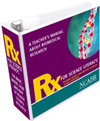
Environmental Factor, December 2011, National Institute of Environmental Health Sciences
Teachers visit NIEHS for science literacy workshop
By Darshini Trivedi
December 2011

As opening speaker, Beard welcomed teachers from across the state to NIEHS. (Photo courtesy of Michael Garske)

Humble guided teachers through the Rx for Science Literacy curriculum, as well as some hands-on activities. (Photo courtesy of Michael Garske)

Blankenship-Paris noted the important contribution of animal models to biomedical research progress. (Photo courtesy of Michael Garske)
With today's rapidly emerging technologies and new scientific issues, K-12 educators are more challenged than ever to prepare themselves and their students for the future. To help bridge the knowledge gap, NIEHS played host to the North Carolina Association for Biomedical Research (NCABR) Nov. 10 for a science literacy workshop. The daylong event, which brought teachers from across the state, provided an overview of the biomedical research process based on NCABR's comprehensive Rx for Science Literacy curriculum manual (see text box).
NCABR is a statewide nonprofit organization dedicated to advancing the public's appreciation for biomedical research. Since its founding in 1989, NCABR has launched several science education and outreach programs such as the Rx for Science Literacy workshop series, which has helped teach 3,600 educators from 94 of North Carolina's 100 counties about the latest in science. At the workshops, educators tour a research facility, hear from scientists about their latest research advances, and take home a free curriculum and other bioscience education materials.
The what, where, how, and why of health science research
Ericka Reid, Ph.D., and John Schelp, from the NIEHS Office of Science Education and Diversity, took the lead in organizing the workshop that drew speakers from around the Institute. The day began with welcoming remarks from Sharon Beard, an industrial hygienist with the Worker Education and Training Program at NIEHS.
Michael Humble, Ph.D., a health scientist administrator in the Cellular, Organs, and Systems Pathobiology Branch, gave an overview of the curriculum, which included several lesson plans about science and biomedical research, as well as classroom activities designed to promote creativity and critical thinking.
Next, a presentation on the humane use of animals in environmental health research was delivered by Terry Blankenship-Paris, D.V.M., head of the Comparative Medicine Branch. Blankenship-Paris emphasized the importance of the use of animals in research, by giving examples of historical contributions of animal models to medical progress. She also noted that 96 percent of animals used in research today are rats and mice, and that the care and use of animals in research is governed by extensive federal regulations.
The remainder of the program included presentations on breast cancer and the environment by Les Reinlib, Ph.D., a program administrator in the Susceptibility and Population Health Branch, and toxicogenomics by Rick Paules, Ph.D., a senior scientist in the Laboratory of Toxicology and Pharmacology.
NCABR members will return to NIEHS June 19, 2012, for a workshop titled “Chemicals, the Environment, and You.” This session will focus on the science of toxicology, to help teachers and students understand the relationship between chemicals in the environment and human health. It also conveys the influence of chemicals on the health of living organisms.
(Darshini Trivedi, Ph.D., is a postdoctoral fellow in the NIEHS Metabolism and Molecular Mechanisms Group.)

Reinlib discussed the latest findings pertaining to environmental factors related to breast cancer. (Photo courtesy of Michael Garske)

A highlight of the day was the tour of the NIEHS facilities. After seeing the high-tech equipment used for research, one of the teachers said, enthusiastically, “I am absolutely amazed by everything.” (Photo courtesy of Michael Garske)
Rx for Science Literacy: The What, Where, How and Why of Health Science Research

Targeted to K-12 educators, the Rx for Science Literacy curriculum manual explains the biomedical research process, the benefits of biomedical research to humans and animals, and the care and use of animals in medical science.
The 300-page manual contains resource materials for in-class use, including handouts, lesson plans, and activities to assist teachers. Topics covered include:
- Processes and benefits of biomedical research
- Careers and ethical issues in medical science
- Information for teachers of health occupations that explains how the manual corresponds to the National Healthcare Skill Standards
The manual has been selected by the N.C. Department of Public Instruction as the primary curriculum for its biomedical technology course, and has been continuously updated and expanded since its initial launch in 1994.
"SRP grantees gather in..." - previous story ![]()
![]() next story - "Panel peer reviews NTP..."
next story - "Panel peer reviews NTP..."
December 2011 Cover Page

